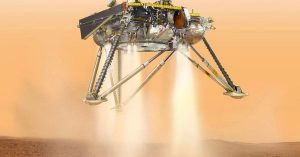
To say NASA Administrator and former Oklahoma Congressman Jim Bridenstine is pumped about the Mars landing is an understatement.
On Sunday, he tweeted:
“Years in the making, tomorrow is the moment of truth for @NASAInSight. We’re landing on Mars! Don’t miss it!”
But it might be hours or days before NASA knows how the InSight Probe manages the landing. NASA engineers say the landing will be what they call “seven minutes of terror.”

After a six-month journey to Mars, the spacecraft will be in a free fall high above the planet, traveling at 12,000 miles per hour and relying on automatic reverse thrusters to make a smooth landing. But the scientists also know their chances of success are slim because only about 40 percent of space missions to Mars have had successful landings.
NASA is trying for its eighth successful landing of a robot on the red planet.
But if the 1,500-pound InSight survives intact, it will be the first spacecraft to monitor quakes on Mars. The craft is nearly 10 years and close to one billion dollars in the making.
It will be landing on the planes of Mars’ Elysium Planitia. The planet’s thin atmosphere can only slow the spacecraft so much, so InSight will also deploy a 39-foot-wide supersonic parachute.
An uneventful arrival is crucial to protecting the spacecraft’s cargo. Short for Interior Exploration using Seismic Investigations, Geodesy, and Heat Transport, InSight’s scientific payload includes an exquisitely sensitive suite of seismometers (for sensing Marsquakes), an 18-inch self-burrowing heat probe (for taking the planet’s temperature), and a five-fingered grappling arm for placing both of the instruments on the planet’s surface. Should any of that equipment become damaged during entry, descent, or landing, it could threaten InSight’s ability to investigate Mars’ interior for clues about its formation, evolution, and composition.






